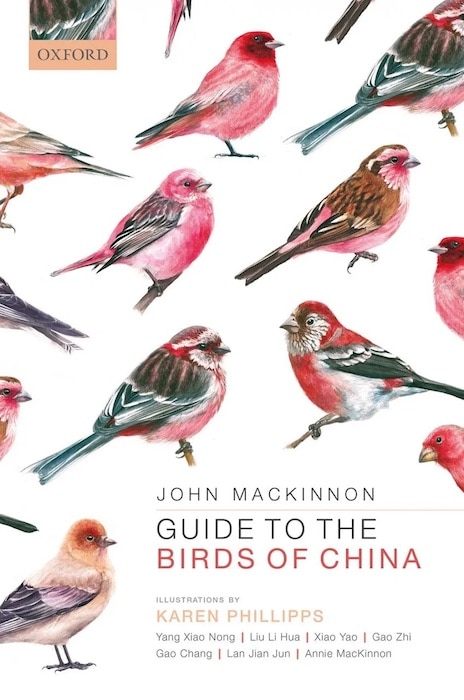| By John MacKinnon(Author), Karen Phillipps Illustrator), Yang Xiao Nong (Illustrator), Liu Li Hua (Illustrator), Xiao Yao (Illustrator), Gao Zhi (Illustrator), Gao Chang (Illustrator), Lan Jian Jun (Illustrator), Annie MacKinnon (Illustrator), Lu Hefen (Contributor), Yifan Li( Contributor), Hu Yun Biao (Contributor) | OUP | 2022 | Paperback | 513 pages, 164 plates with colour illustrations; colour distribution maps | ISBN: 9780192893673 | £29.99p |

The Publisher’s View:
China covers about 7% of the earth’s land surface and encompasses a hugely diverse range of habitats. As a result, it boasts a rich and diverse avifauna, including some of the most spectacular and fascinating birds to be found anywhere in the world.
Building on the enormous popularity and reputation of the original A Field Guide to the Birds of China (2000), John MacKinnon’s fully updated and refreshed work remains a truly comprehensive, taxonomically modern, fully illustrated, and authoritative field guide. 1484 bird species are richly illustrated in 164 annotated colour plates, which are closely integrated with up-to-date colour distribution maps, QR codes providing easy access to birdcalls, IUCN Red List status indicators and new, concise descriptions. These descriptions feature key observations as well as conveying crucial changes to species distributions resulting from climate change and landscape transformation.
Guide to the Birds of China will appeal to an international and growing audience of professional and amateur ornithologists and birding enthusiasts, academic researchers and students, wildlife photographers, and conservationists.
The Authors:
John MacKinnon is an honorary Professor at the Durrell Institute of Conservation and Ecology at the University of Kent in Canterbury, UK. He has spent many years in China working on a variety of conservation projects for WWF, World Bank, European Union, and UNDP. He has written many papers, reports and several books on Chinese biodiversity plus several books on Asian birds. John’s interests range into mammals and butterflies, photography and film-making. His wife Lu Hefen (Monica) has helped widely in the translation and organization of the production and his daughter Annie is an artist who has provided several plates for the book.
The late Karen Phillipps (1948-2020) was born in SE Asia and had a long track record of illustrating books on birds, mammals, and even plants of China and SE Asia. Her interpretations of wildlife are much loved and encouraged and inspired so many readers to become actively involved in appreciating and watching their local fauna. More than 1000 of Karen’s paintings are featured in this book.
Additional artwork has been provided by a total of seven new artists for this book. Yang Xiao Nong has painted the difficult leaf warblers, harriers, and some thrushes; Liu Li Hua has tackled some of the tricky wren babblers and warblers; Xiao Yao has contributed the rosefinches and Yuhinas with Gao Zhi; Gao Chang completed many gap species in several families; Lan Jian Jun contributed many water-birds and shorebirds whilst Annie MacKinnon added new woodpeckers, bulbuls and tits.
Fatbirder View:
This is a difficult one!
It is, of course, the most comprehensive guide to China’s rich birdlife, in itself a massive undertaking which is much to be admired. Moreover, there is a lot of useful information in the opening pages and a useful break down of the geographical structure of this massive country with some extremes of habitat type east west as well as north south. A lot of work has gone into this from a lot of people. So far as I can tell the species accounts are very good and pack a lot into a small space.
So far so good, and even very good.
However, there are two issues; one makes it a difficult book to use quickly and the other is a problem, I think, of too many cooks.
Necessarily, this is a heavy book and physically difficult to heft, but more difficult is the way it is set out. The best fieldguides follow a pattern, plate on the left, words on the right or next to the entry or somehow closely associated with the illustration. You need words and images for difficult ID. Having double page spreads sometimes and not others is awkward, having them at all makes for flicking back and forth trying to find which text matches which plate.
The second issue is that the illustrations vary in style and that jars sometimes. Not surprising given how many illustrators were involved but it does sometimes make you doubt how accurate they are. Helpfully, diagnostic features are often pointed out but some just don’t sit right. Take the bulbuls as an example, they look like water colours where the paint has clotted in places and it doesn’t look natural.
So, in short, its not without issues, but it is still first choice if you intend a visit – especially if you are visiting different provinces.
Fatbirder
